We believe it’s a good time for debt. Benefits include diversification—a lack of correlation to other asset types— as well as returns comprised primarily of income, attractive relative value, and equity cushion to absorb asset stress due to unexpected events. Given current market opportunities, private real estate credit looks particularly attractive today.

At-a-glance
Private real estate credit funds continue to see steady growth in assets under management, and it’s easy to see why:
- Traditional lenders have continued to pull out of the commercial real estate market. At the same time, demand continues to rise (the wall of maturities is now $2 trillion, according to the Mortgage Bankers Association). This combination has created a lender’s market, with favorable conditions including rising spreads and total yields.
- High interest rates have driven capitalization rates higher, which has created opportunities for new investments sized to reset values—generating fresh equity buffers, lower exposure levels, and higher returns.
Introduction
In January 2023, we published The Advantages of Allocating Capital to Private Real Estate Credit, a paper in which we explained the top reasons to invest in private real estate credit. At the time, the advantages included: the capital gap, better entry points at lower post-inflation valuations, and attractive relative value. Those reasons are still valid, in large part because the tailwinds that drove opportunities in the real estate private credit market in 2022 are still driving opportunities today. Given the tailwinds and resulting opportunities that we describe here, it’s no surprise that private real estate credit funds continue to see steady growth in assets under management.
EXHIBIT 1: Allocation to private credit funds continues to rise
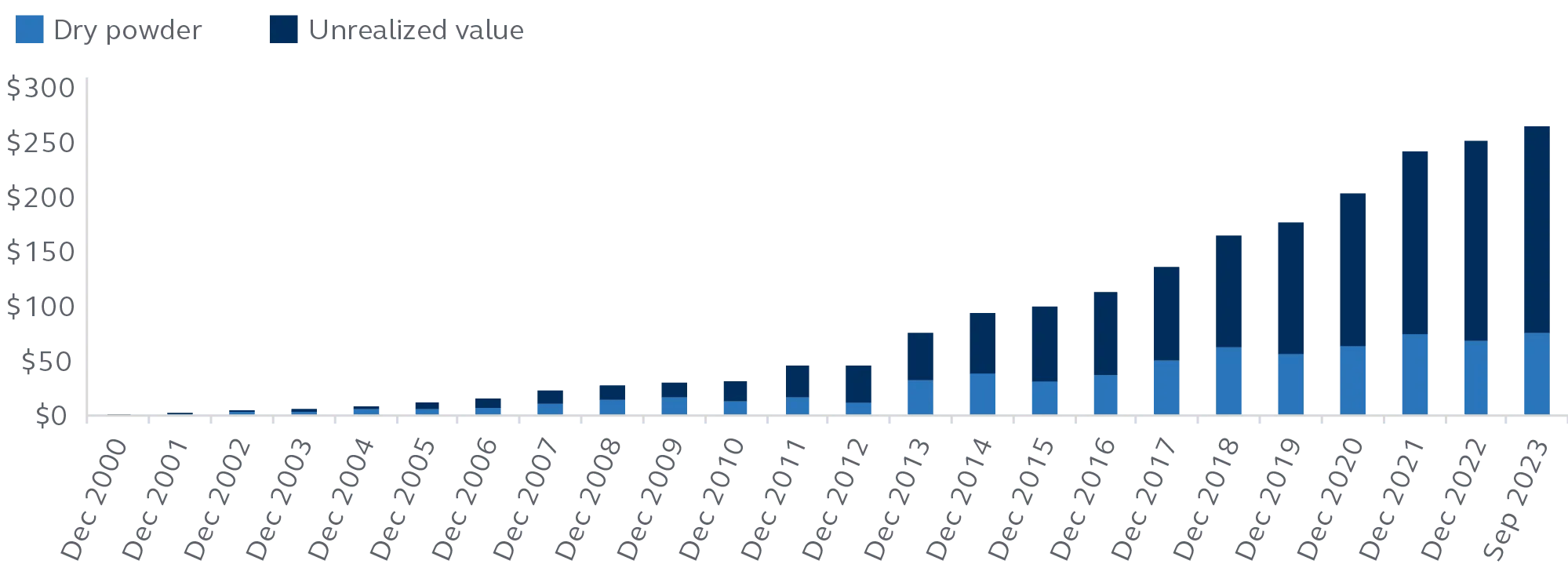
The capital gap persists
Since we last addressed this topic in early 2023, the capital gap that had emerged from a banking sector under pressure and a large wall of coming maturities has not changed for the better:
The banking sector is under pressure on several fronts including bank management teams being concerned about how their books will perform going into the Federal Reserve (Fed) induced economic slowdown. Bank balance sheets are heavy from a flurry of activity in 2021. Banks are also under close scrutiny from regulators and face capital adequacy pressure from stress testing and other factors.
There will be existing loans coming due that need to be paid off and the borrowers will be required to refinance/ recapitalize these assets.
Supply continues to wane
Since 2022, traditional lenders have remained muted. Persistent inflation, continued uncertainty about the economic impact of Fed tightening, and failures including Silicon Valley Bank and First Republic Bank, contributed to a 47 percent decline in commercial lending activity in 2023 over 2022. Banks led the pullback, with a 64 percent decline.
EXHIBIT 2: Commercial lending activity continued to decline in 2023
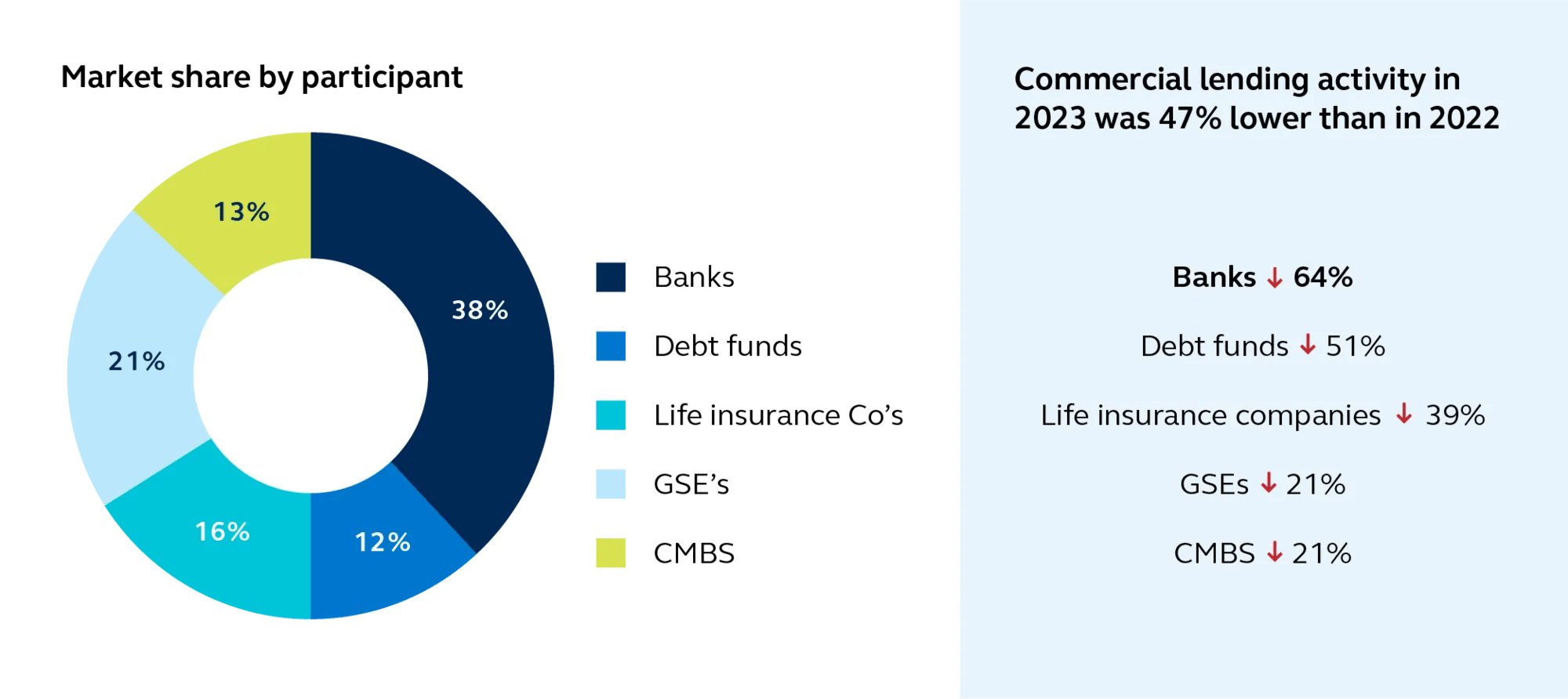
Bank lending is likely to remain muted for the foreseeable future, as the drivers of the conservative mindset persist— including the Fed’s fight against inflation and a lack of visibility on the contour of the slowdown that may result.
Demand continues to grow
The ‘wall of maturities’ continues to grow. There are now approximately $2 trillion in loans maturing over the next three years. Borrowers will be required to refinance/recapitalize these assets—driving huge demand for capital in an environment marked by waning supply.
EXHIBIT 3: $2 trillion in commercial mortgages will mature over the next three years
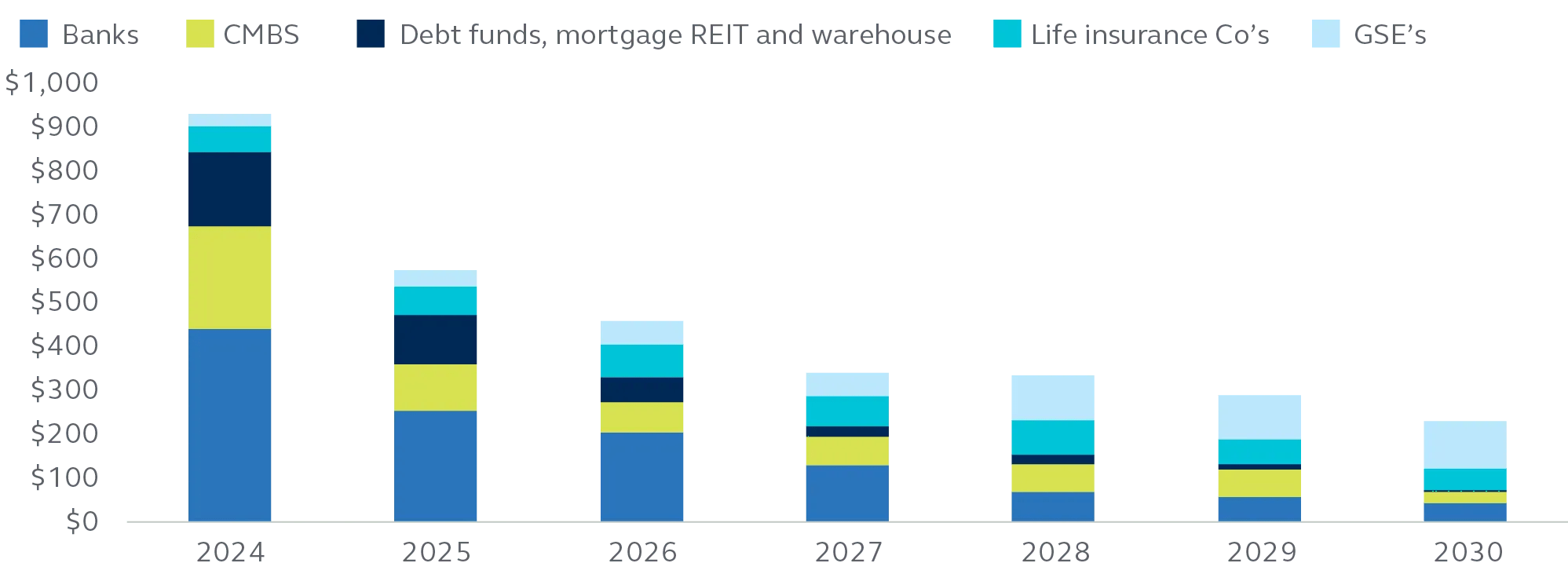
The result: Wider spreads and total yields
This combination of diminishing supply and increasing demand has created a lender’s market, with favorable conditions including rising spreads and total yields
EXHIBIT 4: Mortgage rates and spreads continue to rise
Commerical mortgage rates vs. risk free rate

EXHIBIT 5: Market expectations for short-term rates remain high
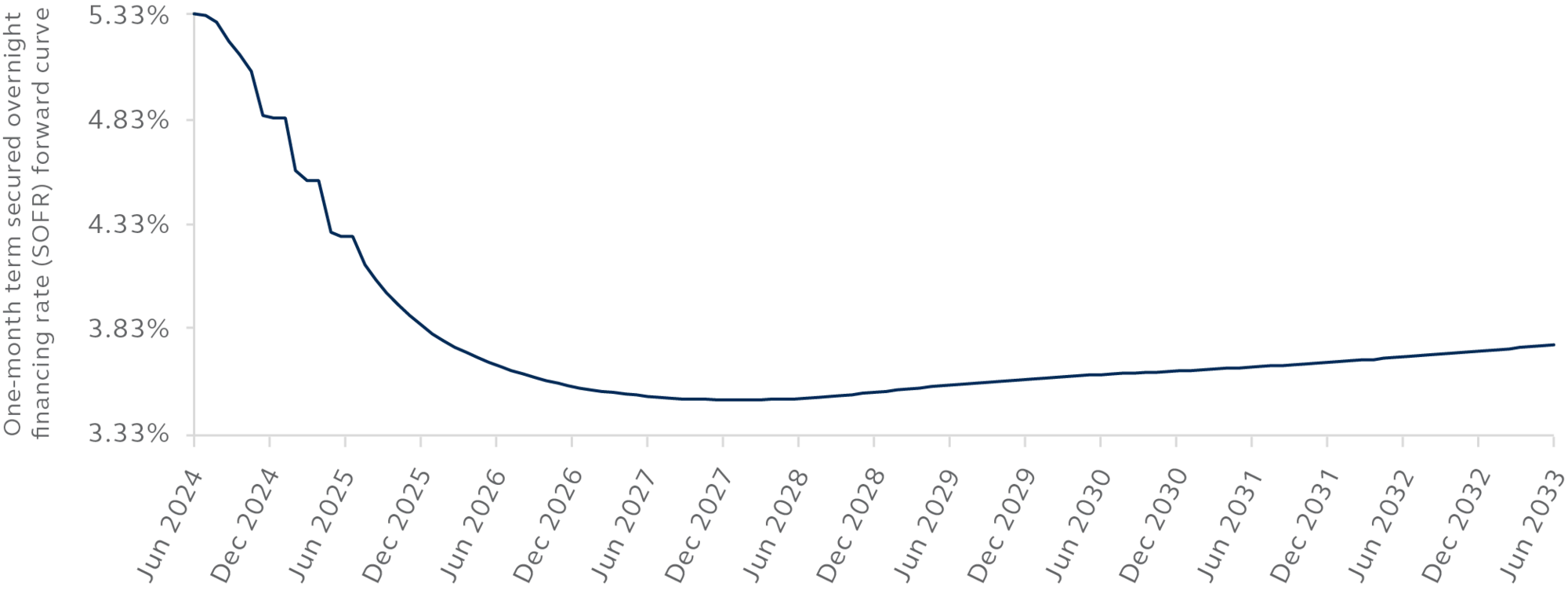
Higher cap rates, lower valuations, more opportunity
The Fed’s series of interest rate hikes and a persistent high interest rate environment have driven capitalization rates higher. That, in turn, has driven valuations down. It has also created opportunities for new investments sized to reset values—generating a fresh equity buffer, lower exposure levels, and higher returns.
Higher cap rates drive collateral valuation drift
For existing loans, higher cap rates means higher loan-to-value (LTV) ratios— and collateral valuation drift. Appraisal valuations are still in the process of catching up with market declines, so portfolio valuation metrics on legacy collateral may appear to be better now than where they may ultimately land in another two to three quarters. Allocations to real estate credit strategies should be made in vehicles targeting new investments.
Higher cap rates also drive attractive returns on reset values
Another reason allocations to real estate credit strategies should be made in vehicles targeting new investments is that new investments will be sized to reset values—which should generate a fresh equity buffer, lower exposure levels, and higher return potential.
EXHIBIT 6: After cap rate increases, legacy LTVs rise
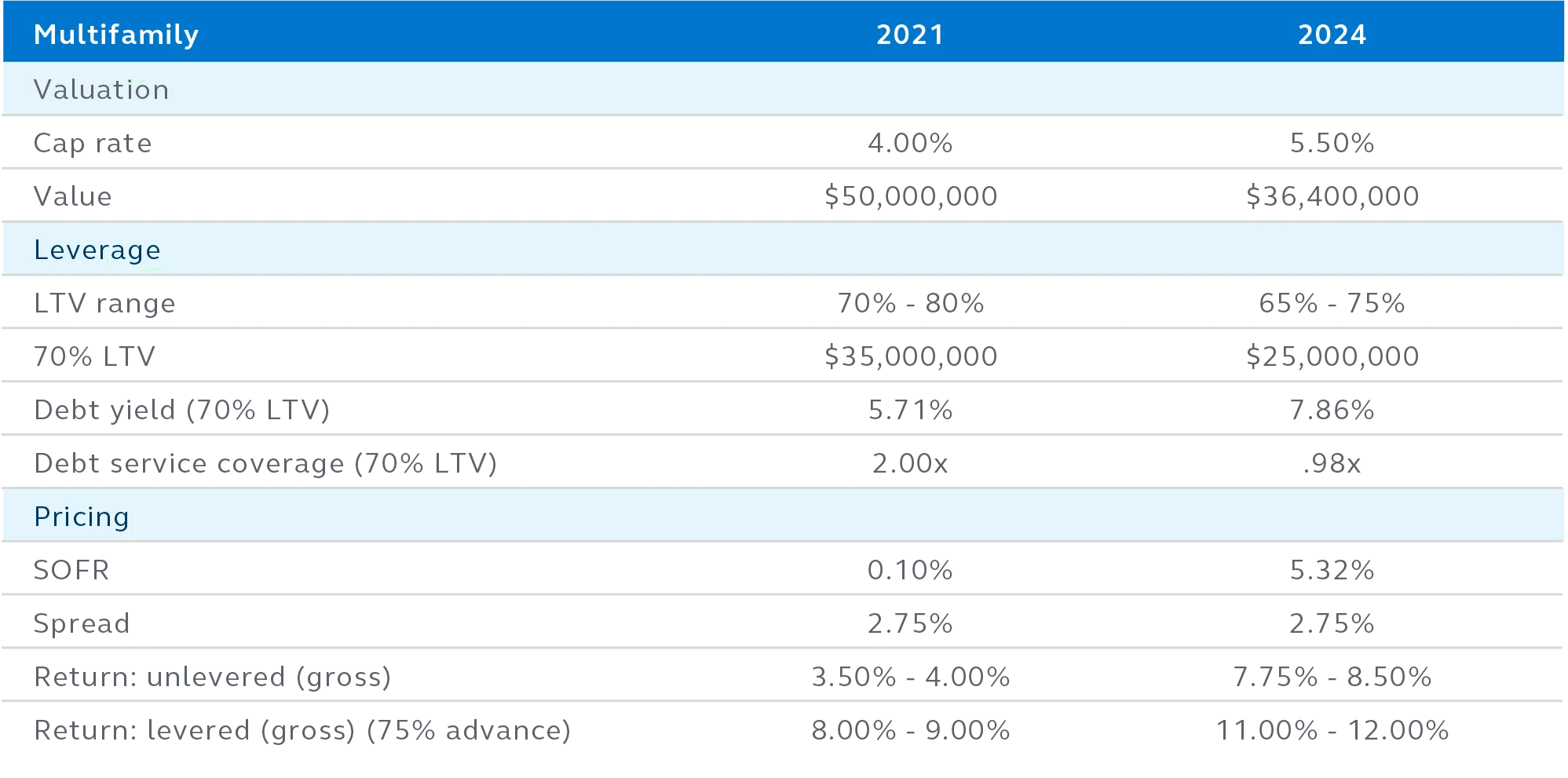
Summary
Historically, the best risk-adjusted credit investments have been made coming out of periods of market turmoil. The next few years are setting up to be the start of a new credit cycle and the role of private lenders is expected to continue expanding. In other words—we believe it is still a good time to invest in private credit.
Get more insights on collateral valuation drift and the challenges with legacy loans in our recent paper Out with the old and in with the new.
For Public Distribution in the United States. For Institutional, Professional, Qualified, and/or Wholesale Investor Use Only in other Permitted Jurisdictions as defined by local laws and regulations.
Risk Considerations
Investing involves risk, including possible loss of Principal. Past Performance does not guarantee future return. Potential investors should be aware of the risks inherent to owning and investing in real estate, including value fluctuations, capital market pricing volatility, liquidity risks, leverage, credit risk, occupancy risk and legal risk. All these risks can lead to a decline in the value of the real estate, a decline in the income produced by the real estate and declines in the value or total loss in value of securities derived from investments in real estate. Private credit involves an investment in non-publicly traded securities which are subject to illiquidity risk. Portfolios that invest in private credit may be leveraged and may engage in speculative investment practices that increase the risk of investment loss. Investments in Private Credit may also be subject to real estate-related risks, which include new regulatory or legislative developments, the attractiveness and location of properties, the financial condition of tenants, potential liability under environmental and other laws, as well as natural disasters and other factors beyond a manager’s control.
Important information
This material covers general information only and does not take account of any investor’s investment objectives or financial situation and should not be construed as specific investment advice, a recommendation, or be relied on in any way as a guarantee, promise, forecast or prediction of future events regarding an investment or the markets in general. The opinions and predictions expressed are subject to change without prior notice. The information presented has been derived from sources believed to be accurate; however, we do not independently verify or guarantee its accuracy or validity. Any reference to a specific investment or security does not constitute a recommendation to buy, sell, or hold such investment or security, nor an indication that the investment manager or its affiliates has recommended a specific security for any client account.
Subject to any contrary provisions of applicable law, the investment manager and its affiliates, and their officers, directors, employees, agents, disclaim any express or implied warranty of reliability or accuracy and any responsibility arising in any way (including by reason of negligence) for errors or omissions in the information or data provided. All figures shown in this document are in U.S. dollars unless otherwise noted.
This material may contain ‘forward looking’ information that is not purely historical in nature. Such information may include, among other things, projections and forecasts. There is no guarantee that any forecasts made will come to pass. Reliance upon information in this material is at the sole discretion of the reader.
Integration of sustainability considerations and/or environmental, social and governance (ESG) factors is qualitative and subjective by nature. There is no guarantee that the criteria used, or judgment exercised, will reflect the beliefs or values of any particular investor. There is no assurance that any strategy or integration of sustainability considerations and/or ESG factors will be successful or profitable.
This material is not intended for distribution to or use by any person or entity in any jurisdiction or country where such distribution or use would be contrary to local law or regulation.
This document is issued in:
- The United States by Principal Global Investors, LLC, which is regulated by the U.S. Securities and Exchange Commission.
- Europe by Principal Global Investors (Ireland) Limited, 70 Sir John Rogerson’s Quay, Dublin 2, D02 R296, Ireland. Principal Global Investors (Ireland) Limited is regulated by the Central Bank of Ireland. Clients that do not directly contract with Principal Global Investors (Europe) Limited (“PGIE”) or Principal Global Investors (Ireland) Limited (“PGII”) will not benefit from the protections offered by the rules and regulations of the Financial Conduct Authority or the Central Bank of Ireland, including those enacted under MiFID II. Further, where clients do contract with PGIE or PGII, PGIE or PGII may delegate management authority to affiliates that are not authorised and regulated within Europe and in any such case, the client may not benefit from all protections offered by the rules and regulations of the Financial Conduct Authority, or the Central Bank of Ireland. In Europe, this document is directed exclusively at Professional Clients and Eligible Counterparties and should not be relied upon by Retail Clients (all as defined by the MiFID).
- United Kingdom by Principal Global Investors (Europe) Limited, Level 1, 1 Wood Street, London, EC2V 7 JB, registered in England, No. 03819986, which is authorized and regulated by the Financial Conduct Authority (“FCA”).
- This document is marketing material and is issued in Switzerland by Principal Global Investors (Switzerland) GmbH.
- United Arab Emirates by Principal Global Investors LLC, a branch registered in the Dubai International Financial Centre and authorized by the Dubai Financial Services Authority as a representative office and is delivered on an individual basis to the recipient and should not be passed on or otherwise distributed by the recipient to any other person or organisation.
- Singapore by Principal Global Investors (Singapore) Limited (ACRA Reg. No. 199603735H), which is regulated by the Monetary Authority of Singapore and is directed exclusively at institutional investors as defined by the Securities and Futures Act 2001. This advertisement or publication has not been reviewed by the Monetary Authority of Singapore.
- Australia by Principal Global Investors (Australia) Limited (ABN 45 102 488 068, AFS Licence No. 225385), which is regulated by the Australian Securities and Investments Commission and is only directed at wholesale clients as defined under Corporations Act 2001.
- Hong Kong SAR (China) by Principal Asset Management Company (Asia) Limited, which is regulated by the Securities and Futures Commission. This document has not been reviewed by the Securities and Futures Commission.
- Other APAC Countries/Jurisdictions, this material is issued for institutional investors only (or professional/sophisticated/qualified investors, as such term may apply in local jurisdictions) and is delivered on an individual basis to the recipient and should not be passed on, used by any person or entity in any jurisdiction or country where such distribution or use would be contrary to local law or regulation.
Principal Global Investors, LLC (PGI) is registered with the U.S. Commodity Futures Trading Commission (CFTC) as a commodity trading advisor (CTA), a commodity pool operator (CPO) and is a member of the National Futures Association (NFA). PGI advises qualified eligible persons (QEPs) under CFTC Regulation 4.7.
Principal Funds are distributed by Principal Funds Distributor, Inc.
© 2024 Principal Financial Services, Inc. Principal®, Principal Financial Group®, Principal Asset Management, and Principal and the logomark design are registered trademarks and service marks of Principal Financial Services, Inc., a Principal Financial Group company, in various countries around the world and may be used only with the permission of Principal Financial Services, Inc. Principal Asset Management℠ is a trade name of Principal Global Investors, LLC. Principal Real Estate is a trade name of Principal Real Estate Investors, LLC, an affiliate of Principal Global Investors.
MM14058 | 07/2024 | 3678460-122025


